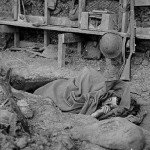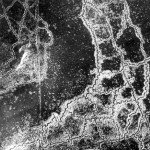

Trench warfare is perhaps the most iconic feature of World War I. By late 1916 the Western Front contained more than 1,000 kilometres of frontline and reserve trenches. Enemy attacks on trenches or advancing soldiers could come from artillery shells, mortars, grenades, underground mines, poison gas, machine guns and sniper fire. Soldiers in the trenches endured conditions ranging from barely tolerable to utterly horrific. Exposed to the elements, trenches filled with water and became muddy quagmires. One of the worst fears of the common Western Front soldier was ‘trench foot’: a gangrene of the feet and toes, caused by constant immersion in water. Trench soldiers also contended with ticks, lice, rats, flies and mosquitos. Diseases like cholera, typhus and dysentery thrived because of vermin, poor sewage and waste disposal, stagnant water, spoiled food and unburied bodies.
If the Western Front was a breeding ground for disease then the territory between its opposing front lines – ‘no man’s land’ – was a veritable nightmare. Chewed into mud and craters by shell fire, strewn with barbed wire, discarded rubbish, bodies and body parts in all stages of decomposition, the soldiers dreaded it. One English officer toured ‘no man’s land’ and reported:
“I climbed into the field, which of course consists of shell holes, and had a look ’round. Along by the high banks of the trenches thousands of tins are lying: bully beef, jam, soup, cigarette, sausage, etc. Bits of iron and bits of shell are everywhere, and here and there are fuses, our own and the enemy’s (since this ground was once in German hands). I found a dugout that had got lost and took some crockery out of it. Corpses had been uncovered so I had some men out to rebury them. Every shell that falls here disturbs some wretched, half-decayed soldier. Farther back on the other side of the German wire, all smashed to bits, there were a dozen dead men, two of them lieutenants. I got a party of men and buried the poor fellows. They were all blackened, and the hands were almost fleshless. Over each man’s mount we stuck a rifle and bayonet, with his cap on the rifle butt.”
Trench warfare itself was not an invention of World War I. It had been called into service in the American Civil War (1861-65) the Boer War (1899-1902) and elsewhere. It was the scale and the industrialised nature of World War I that transformed battle and made trench warfare the norm, rather than an occasional strategy. Soldiers once equipped with bayonets and barely accurate rifles now found themselves with heavy artillery, machine-guns capable of 400 rounds per minute and precision-firing small arms. Yet for all these advances in weaponry, the armies of World War I were largely formed as they had been a century before: mostly infantry (foot-soldiers) with some cavalry (soldiers on horseback). Regardless of size or strategy, they were largely defenceless against this new firepower, particularly when advancing. Generals who had no effective tactical solutions soon resorted to trench warfare, where they could at least hold position. Contrary to popular opinion, there were very few generals who deliberately butchered soldiers by ordering futile charges against machine-guns and heavily defended positions. Manpower was not so plentiful that any general would consider wasting soldiers in pointless attacks. The blunders of the Western Front were more commonly caused by an age-old military error: underestimating the strength of the enemy’s men or overestimating your own.

The Western Front itself was not one long trench but a complicated trench system. Both the Allies and the Central Powers relied on a three-trench network, each running parallel to the enemy and connected by communications trenches. This pattern is visible in an aerial photograph of a trench network (see picture) which shows German trenches on the right, Allied trenches on the left and ‘no man’s land’ between them. Having multiple lines of trench allowed soldiers to retreat, if the frontline trench was overrun or destroyed by the enemy. Reserve trenches also provided relative safety for resting soldiers, supplies and munitions. Trenches were usually dug in a zig-zag pattern rather than a straight line; this prevented gunfire or shrapnel from being projected along the length of a trench, if a shell or enemy soldier ever landed inside. Other common features of Western Front trenches were dugouts (underground shelters or offices) and ‘bolt holes’ or ‘funk holes’ (sleeping cavities, hacked into trench walls). Most digging and maintenance work in the trenches took place at night, under cover of darkness, so soldiers often spent daylight hours huddled and sleeping in these small spaces.
“At many places along the opposing line of trenches, a ‘live and let live’ system evolved, based on the realisation that neither side was going to drive out the other anyway. It resulted in arrangements such as not shelling the latrines or attacking during breakfast. Some parties even worked out arrangements to make noise before lesser raids so that the opposing soldiers could retreat to their bunkers.”
Jackson J. Spielvogel, historian
Soldiers did not spend all or even most of their time in frontline trenches. Unless a major offensive was imminent, the roster had most men spending six days in the trench system and six days well back from the front line. Only two or three days of this six-day rotation was spent in the frontline trench itself; the rest was spent in reserve or support trenches. The duties of a trench soldier varied widely. Maintenance – digging new trenches, repairing old ones, draining water, filling sandbags, building parapets and unfurling barbed wire – was never-ending (some soldiers’ accounts tell of more back-breaking labour than actual fighting). Food supplies in the trenches were adequate until late 1915, after which shortages and interruptions to shipments created problems. Meat was in short supply so most soldiers relied on ‘bully beef’ (canned corned beef). Bread took 6-8 days to reach the trenches so was invariably stale; a common substitute was ‘hardtack’, a flavourless biscuit that stayed fresh for years but was so brick-hard it had to be soaked in water or soup. By 1917 food was so scarce that some units were fed with whatever could be scrounged locally. One Allied regiment was given a watery soup brewed from grass, weeds and thin strips of horsemeat.

1. Trench warfare was used extensively on the Western Front by both sides, after the Battle of the Marne in 1914.
2. At its core, trench warfare was a form of defensive warfare intended to halt enemy assaults and advances.
3. Trench systems were extensive and complex, intended to hinder an enemy assault while allowing for fallback positions.
4. This type of warfare was difficult and dangerous, both because of the fighting and the adverse conditions in trenches.
5. The area between the trenches was dubbed ‘no man’s land’ and was strewn with mines, craters, mud, unexploded ordinance, barbed wire and countless bodies.